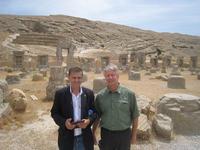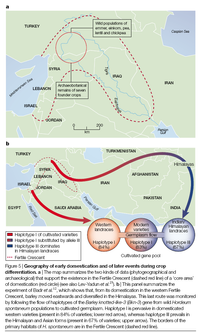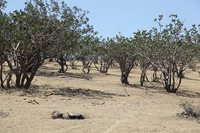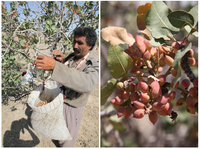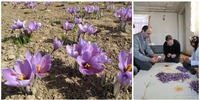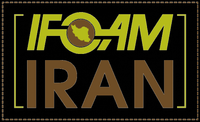Country report: Iran
Organic agriculture has a rapid development in Iran, with increasing interest from consumers and agricultural students. Being a centre of evolution of agriculture, organic agriculture represents an interesting alternative for a fruitful development of traditional farming methods.
Iran: A land of high value organic products
The future for organic agriculture in Iran is very positive. The growth rate, experienced over the last few years, suggests a fast and considerable development of the sector. Iran may become a central area for producing high value organic products with a world-wide demand, such as Saffron, Pistachio, Pomegranate and Medical plants. Cultural studies have shown that Iranians always were interested in traditional products originating from the villages. Hence, organic products are favored because they are considered free from toxic chemicals, additives, artificial flavorings and colorings, preservatives, and are perceived as having a higher quality.
Iran, the second largest country in the Middle East, is located in the southwest of Asia with an area of 1.65 million km2. IFOAM President Andre Leu visited Iran together with ISOFAR President Gerold Rahmann in 2014. During their visit to Persepolis – more than 2500 years old- they stated the importance of Iran as a center for the evolution of agriculture (Fertile Crescent). Since people engaged in agriculture first settled here some 10,000 years ago, Iran is the origin of many domesticated plants and animals which are among the main sources of food for human beings all over the world, as indicated by Figures 1 and 2.
Persepolis; Shiraz- Iran 2014, Left: Andre Leu- President of IFOAM (Australia); Right: Prof. Gerold Rahmann- President of ISOFAR (Germany)
Figure 1. From Purugganan & Fuller, 2009. Nature 457, 843-848.
Figure 2. From Salamini, Ozkan et al. 2002. Nat Rev Genet 3:429–441.
Iran has a diverse physiography, climate, vegetation and biological productivity (Koocheki and Ghorbani, 2005). Traditional small scale farming was the main structure of farming communities for centuries. Here, the land management was based on indigenous farming systems, practices and knowledge associated with self-sufficiency and family associated communities.
However, with the advent of new technologies this has been changed but no proper alternatives have been introduced (Koocheki, 2004). About 86 percent of farmers in Iran are smallholders who manage close to 40 percent of arable lands in Iran (Koocheki, 2004; Mahmoudi et al, 2007), without access to agrochemicals, and traditional mixed farming systems remain prevalent. In small-scaled farming systems, ecological practices are still prevalent which include:
- Diversified crop, animal husbandry integrated
- Use of animal manure, wastes and by-products for soil improvement
- Biological pest and disease control
- Community cooperation, family labor and local market orientation
These systems may be considered as organic farming by default (Koocheki and Ghorbani, 2005), or non-certified organic agriculture (Mahmoudi and Mahdavi Damghani, 2008).There is an increasing public concern about food safety, but only few people really know about organic farming.
Organic agriculture in Iran started within universities, and is taught in specific courses and lectures since 25 years ago. The most important challenge of transition to organic agriculture is the management of plant nutrition and protection against pests, diseases and weeds during the first years of conversion to prevent yield reduction.
Organically cultivated area in Iran
Parallel to the interest for organic agriculture within the universities, the market began to develop. Certified organic products in Iran have been available since 1999, when an orchard with roses for extracting essential oils in Kerman province was converted. In 2006, a company in the province of Fars was certified to export organic Pomegranate, Figs, Dates, and Medicinal herbs to the EU. Since then, the organic market has been growing rapidly. Recent statistics published by IFOAM & FiBL show that there are 43000 hectares under organic management, and about the same certified for wild collection.
Organic Honey production in central part of Iran.
Organic Tea production in the mountains area of northern of Iran.
The only densed wild Pistachio forest in the world located in Northern East of Iran.
Iran is the main origin of Saffron production in the world.
Opportunities for Organic Agriculture in Iran
As in many countries in the Mid-East, the domestic market for organic products in Iran is still relatively small. However, local demand for organic products has been growing parallel with consumer awareness as well as concerns related to a number of food safety issues. It is typical for developing countries that the domestic organic market starts in the capital city with small corners in the supermarkets. These shops are usually in residential areas that are inhibited by upper- and middle class citizens (Sirieix et al., 2011; Kledal et al., 2009, 2010, 2012) especially in northern part of (capital) Tehran.
The main problem for organic market growth is a consistent supply of products. Organic agriculture may enable Iranian smallholders to achieve household food security and gain better incomes while regenerating the land, enhancing biodiversity, and supplying quality food to local communities (Mahmoudi and Mahdavi Damghani, 2009). At present, there is increased interest for organic products for export. The majority of the organic production in Iran is being exported (Kledal et al., 2012). The main importing countries of Iranian organic products are Germany, France, The UK, The Netherlands and some countries in East Asia (Mahmudi & Damghani, 2011).
Standards and Regulation
An updated version of "Requirement of production, processing, inspection & certification, labeling and marketing of organic food (INSO - 11000)" was published by the Institute of Standards and Industrial Research of Iran (ISIRI) in 2014, in cooperation with universities and private companies. In these standards, a list of permitted organic inputs was included. The first draft of "Organic Wild Collection: Plant Collection Guideline" was released by ISIRI in 2009.
National support for developing Organic Agriculture
The Ministry of Agriculture recently established a 'Committee on Organic Agriculture' to make a policy and provide an action plan for the development of organic agriculture in Iran. An Agricultural Research, Education and Extension Organization has introduced a program to implement a new research department called "Farming Systems", where a research program for organic agriculture was included. Governmental subsidies on agrochemicals have been reduced dramatically since 2007, which may contribute to a positive development for organic agriculture.
Research and education
Research programs on organic agriculture production, processing and marketing are carried out by several institutions, including the Environmental Sciences Research Institute of Shahid Beheshti University in Tehran, Ferdowsi University of Mashhad and Islamic Azad University, Karaj Branch. Activities are carried out as students' theses, or research projects. A postgraduate course on agroecology has been extended to several of universities across the country. The Iranian Scientific Society of Agroecology (ISSA) has since 2008 conducted regular meetings on sustainable agriculture in which organic agriculture is one of the common topics. A Center of Excellence of Organic Agriculture of Iran is supported by the Ministry of Education, and works to disseminate knowledge on organic farming in Iran.
Non-governmental organizations and private companies
NGO's play an important role to develop the organic movement in Iran, especially since a majority of people cannot define what organic means, and how it differs from non-organic products. The Iran Organic Association (IOA) is supported by the Iran Chamber of Commerce. IOA works with market development, and supports all people and organizations active in developing organic farming in Iran. Since 2011, IOA conducts an annual international congress and various workshops, and promotes organic business by international and national networking. IOA recently established a GMO debate committee. IOA also has a strong collaboration with the municipality of Tehran and conducts the annual "Tehran Organic Week Festival", which provides an opportunity for organic producers to introduce their products to consumers as well as increasing public awareness through media.
IFOAM- IRAN was established in May 2014, initiated by the IOA, and is also supported by Iran Chamber of Commerce.
Center for Sustainable Development & Environment, CENESTA is a non-profit organization dedicated to promote sustainable community and culture based development. Its main area of work is Iran and Southwest Asia. CENESTA experts are also active in Africa, Latin America and on the international arena in general. CENESTA is a member of IUCN—the World Conservation Union, and is affiliated with the University of the North (Iran).
In line with the increasing organic area, production of organic inputs such as fertilizers and bio-control agents such as parasitoids and predators insects is an increasing industry for private companies across the country.
Author
Dr. M. Reza Ardakani
Professor of Agroecology and Organic Farming, Azad University, Karaj Branch, Iran
Board Member, International Society of Organic Agriculture Research (ISOFAR)
mreza.ardakani@gmail.com
